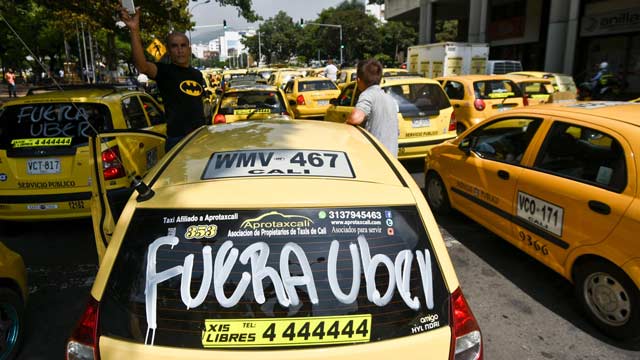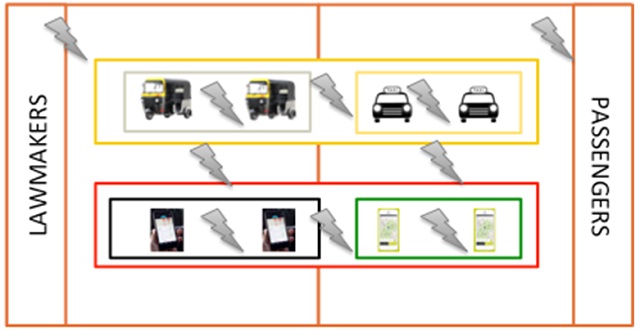
The last couple of weeks have been fascinating for a positivity strategist like me. There is a discernible increase in decibel levels of “us” and “them”. From the point of view of spurned opportunities, it is disappointing. But nevertheless, it holds many lessons.
Let’s take football. On one hand, you have street skirmishes between fans of opposing teams. If you followed the 2014 FIFA World Cup, you might remember this distraught spectator. Clovis Acosta Fernandes, also known as ‘Gaucho da Copa’, became the symbol of the loss Brazil suffered at the hands of Germany in the semi-final of the tournament.

Screenshot of Clovis Acosta Fernandes hugging the replica of the trophy. via YouTube
But there was another story here. After the match, Fernandes handed over the replica of the trophy to a German fan and reportedly said, “Take it to the final. As you can see, it’s not easy. But you deserve it. Congratulations.” That is such a sweet lesson.
Rivalries spill onto playing fields. You have players who can transition from the roles of enemies to friends.
Just a couple of weeks back, Ronaldo, Pepe and Gareth Bale played as teammates for Real Madrid to defeat Atlético Madrid in the UEFA Champions League final in Milan. In a few days, Ronaldo and Pepe will play for Portugal against Gareth Bale who plays for Wales for a spot in the final of the Euro 2016, being played in France.
Ronaldo, Bale and Pepe in Real Madrid colours.
Above:Ronaldo and Pepe in Portugal colours. Below: Bale in Wale colours.
Come August, when the Spanish La Liga and the German Bundesliga kick off, the national colours will be put aside and the same players will start playing with each other. In another continent, everyone who has gone up against Leo Messi came out in full support of him after his heart-breaking failure and subsequent retirement.
I know what you are thinking. How does this apply to business? Allow me to explain through an industry which has been in the news. I am an ardent user of public transport. Across the word, this industry transports millions of passengers to their destinations every single minute of every day.
Autos, Taxis, Uber— I use them all. No sooner have I settled into my selected mode of transport, I switch into conversation mode. Engaging in conversations to listen to their life stories is an inspirational experience. You do not need videos urging you to “stay hungry / foolish” or “lean-in” or “follow your passion”. Just listen to their life stories.
You get to learn some very interesting facets of their lives and thought processes. A prime concern is the increasing competition for the same limited number of customers. It is a fight for market share and productivity. Auto drivers and taxi drivers are concerned about the increasing number of “online-transportation network companies” such as Uber and Ola. I have seen auto drivers get into fights with other auto drivers. Drivers of the network companies complain about the lowering margins, thanks to lower price entrants within their own network. There is what you would call “intra-sector competition”. Autos are competing with autos for the same passengers. Uber Drivers are competing with Uber drivers for the same segment.
Its auto drivers vs auto drivers and Uber drivers vs Uber drivers.

Autos vs Uber
How do auto drivers get united? When they start bad mouthing the black and yellow taxis. The conflict of auto drivers and the famous black and yellow taxi drivers goes back many decades.

Autos vs Black and Yellow taxis
Now let's switch over to the other end of the spectrum. In the last few weeks, we have seen an escalation in the attritional verbal war between two of the largest online networks mounting challenges and defenses in court and media.

Uber vs Ola
Meanwhile, taxi strikes are erupting everywhere. The conflict between taxis and Uber is spilling onto the streets.

Taxi drivers demonstrate against the ridesharing service Uber, in Cali, Colombia, on June 28, 2016. AFP
Interestingly all of them have been in constant conflict with two important stakeholders— lawmakers and consumers. In some states, stricter norms are being levied against network companies. In Mumbai airport, I have to pay Rs 110 to enjoy the privilege of adding to the traffic population of the city. The airport operators are leveraging the opportunity to their advantage.
On the other hand, customers have to deal with the vagaries of online networks. Understandably, none of them are perfect and have downsides, which aggravates both consumers and lawmakers.
Today, and perhaps in the next few columns, I am going to address the conflict from a positivity lens. How might these seemingly disparate entities work together? It is easier than it seems.
This is what the overall conflict map looks like. You can see the number of potential conflagration zones.

Let’s step back to a short story of Buddha’s journey to enlightenment. As Siddhartha set out on his journey, he encountered Mara, a demon. Mara was hell bent on denying Siddhartha the seat of enlightenment. He wanted it for himself. Mara offered to make Siddhartha the “universal monarch”, which he refused, and continued his journey to Bodh Gaya. Sitting under the Bodhi Tree, Siddhartha takes the ‘Middle Way’ or a path of moderation to attain awakening or enlightenment.
Mara is determined to stop him. He sends his army of Lust, Conceit and False glory; Aversion and Cowardice; Craving, Hunger and Thirst; Sloth, Stupidity, Doubt and Hypocrisy. Siddhartha is unwavering. Mara goes away disappointed.
Mara has three daughters— Tanha (Craving), Arati (Discontentment and Aversion), and Raga (Greed and Desire). They undertake a mission to distract Siddhartha. You can find a poetic description of the distractions that Mara’s daughters throw at Siddharth here. They fail in their mission.
On the night before enlightenment, Mara makes his final attempt to win the seat. He confronts Siddhartha and asks him to prove that the seat belongs to him. Siddhartha’s followers claim that they are witnesses, only to be countered by Mara’s followers who vote for him. They reach a position of stalemate. Siddhartha then touches the earth with his right hand and asks Mother Earth to bear witness and to defy Mara’s claim to the seat of enlightenment. Mother Earth responds with a huge roar, saying “I bear witness”. Thus Mara was defeated and Siddhartha went on to become the Bodhisattva Buddha.
One would think, that an enmity with someone like Mara would last a lifetime. After all, he was the biggest hurdle in your path. Everyone disliked Mara, including Ananda, Buddha’s attendant, who had the gift of a vast memory. Ananda remembered everything.
Buddhist monk Thich Nhat Hanh wrote a story where Mara demands to be allowed to meet Buddha. Ananda refuses his request, stating that Buddha would not like to meet Mara, since he is an enemy. Now you have to remember that Mara is very intelligent. He replies, “Are you saying that Buddha has enemies?” Ananda does not have a reply. He relents and goes into the cave to ask the enlightened one. “Mara seeks an audience, I have refused, but he insists that I ask you”. Ananda expects Buddha to refuse an audience. Buddha emerges from his meditation, smiles and says,"Mara! Wonderful! Ask him to come in!" Ananda goes out and sends Mara in. As Mara enters, Buddha welcomes him with an embrace and offers him the best place to sit. He asks Ananda to make them tea. He then says to Mara, “Dear friend, how have you been? Is everything okay?”
In another interpretation of the story, Buddha is in a state of meditation, and he sees Mara lurking in the bushes. He opens his eyes and says, “I see you, Mara. Come, let’s have some tea”.
Once tea is served, Buddha asks Mara about his well being. Mara replies that he is very exhausted because of the strenuous demands of the role that he has been playing. The role of a wicked demon demands that he is always wicked and deceitful. Everyone expects him to be a terrible all the time. He says that he wants to change roles with the Buddha.

I want to end this column, asking you to consider this question.
When Mara comes calling, what will you do? Mara takes the form of unwanted emotions. It can take the form of a much despised competitor. Mara might appear as a rude, irate, and irrational customer. It might seem that the worst reincarnation of Mara is visiting you, when you meet, lawmakers and the people who hold power over you.
The first step in a conflict soaked environment is to invite the many forms of Mara for tea. Working with Mara can help
Discover: Mara brings with it a great amount of information. Ignore it at your own peril. You might find perspectives that you never considered before. You might figure out that you have more interests in common.
Deconstruct: Sitting down with Mara for a meaningful conversation, can help you peel away the layers of mindsets and belief systems.
Development: Dealing with Mara need not be a zero-sum game. Every conversation increases the stakes. Working with competitors, across domains of life, usually increases the market size.
To conclude, in football, there is a very interesting ritual. At the end of every game, players will swap their sweat-soaked jerseys with a member of the opposite team. They will console and congratulate each other. It is a poignant reminder that football is a battle for just those ninety minutes.
Perhaps this is how footballers transition from being friend to foe to friend again. Let’s learn from this. It is about building a positive ecosystem. It is about embracing Mara and inviting him for tea.
The author is the Founder of The Positivity Company where he helps business leaders become more positive and productive.Birender can be reached on birender.ahluwalia@gmail.com.